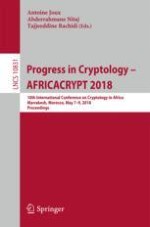This book constitutes the refereed proceedings of the 10th International Conference on the Theory and Application of Cryptographic Techniques in Africa, AFRICACRYPT 2018, held in Marrakesh, Morocco, in May 2018.
The 19 papers presented in this book were carefully reviewed and selected from 54 submissions. AFRICACRYPT is a major scientific event that seeks to advance and promote the field of cryptology on the African continent. The conference has systematically drawn some excellent contributions to the field. The conference has always been organized in cooperation with the International Association for Cryptologic Research (IACR).
